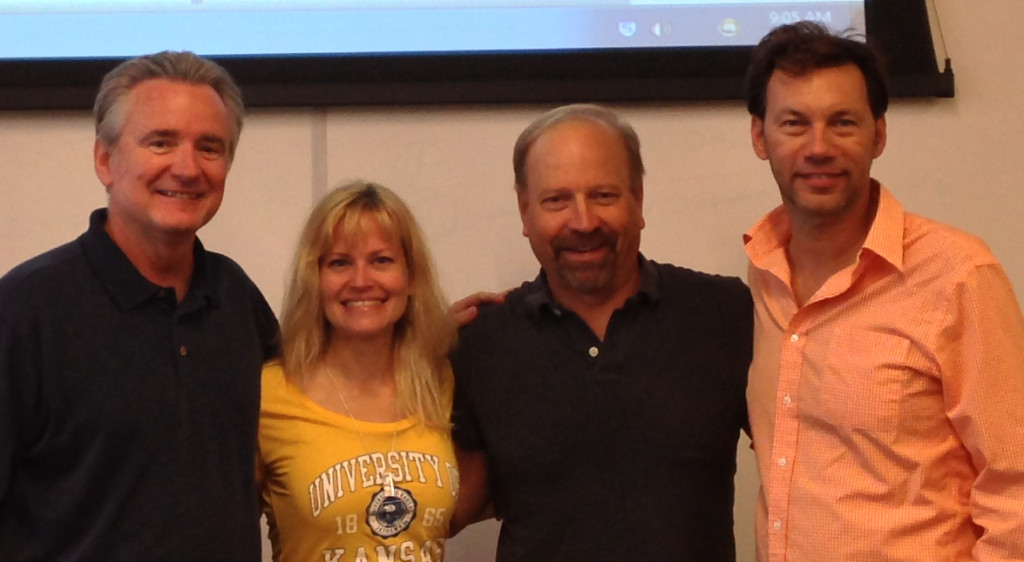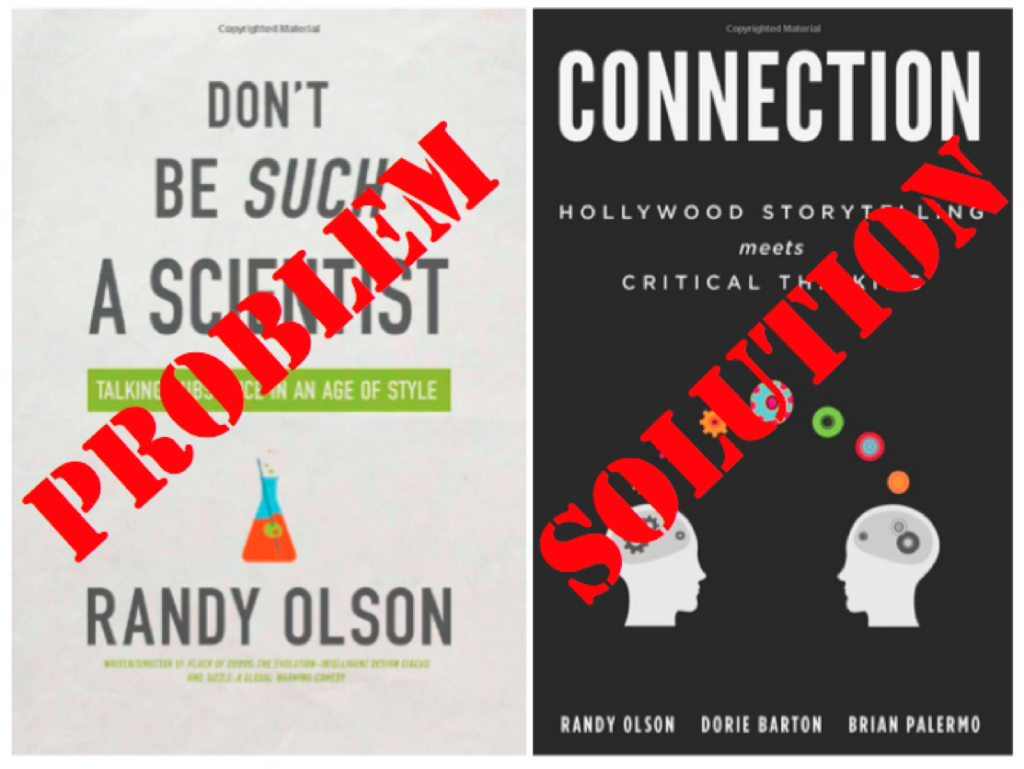#301) My Two Books: “Problem,” then “Solution”
September 16th, 2013
With “Don’t Be Such a Scientist” (first book) I offered up a critique of science communication for which some rightfully replied, “Okay, so what’s the solution?” The new book, “Connection: Hollywood Storytelling meets Critical Thinking” answers by advocating and demonstrating: 1) collaboration with less cerebral partners, 2) a more critical (structured) approach to storytelling, and 3) the WSP Model.
WE’RE NOT IN KANSAS ANY MORE. But we were for 3 wonderful days — hosted by Dr. Steve Case (left) of the University of Kansas (who was one of the stars of my movie, “Flock of Dodos,”) where we launched the book and the reborn version of our Connection Storymaker Workshop. It was a great and productive trip. Next stop for our traveling road show will be the Monterey Bay Aquarium, October 16-17.
TWO BOOKS. 2009 – Don’t Be Such a Scientist (PROBLEM), 2013 – Connection (SOLUTION)
space
SOLUTION-ORIENTED COMMUNICATIONS ADVICE
Fair enough. Some of the reviews of my first book, “Don’t Be Such a Scientist,” complained that I didn’t provide specifics on how to improve science communication. I pointed in a direction, but to some extent it was like Dorie’s bit in her section of the new book where she says, “How do you fix a leaky faucet? You fix it.”
The new book is oriented at the entire world. It’s not written for the science world, and because it doesn’t have the word “science” in the title probably will be dismissed by some of the more literal-minded science folks. But it provides the solutions yearned for by critics of the first book. Here’s the three most important recommendations.
space
1) COLLABORATION IN THE VISCERAL DIRECTION
“Don’t tell us, show us.” They drilled this into our heads in film school. I’ve done my best to follow it with this new book. With my “nerdloop” essay a couple of years ago I implored the science world to quit moving so much in the cerebral direction with endless research, and instead reach towards the more intuitive, visceral, experiential direction. Which is what I have done.
Instead of forming a partnership with two academics, I put in 20 years of learning the craft of acting (starting in 1994), learning the language of actors, forming friendships with actors, working with improv instructors, and finally out of the hundreds of actors I met in those 20 years, I chose the two very best for the mission.
They both have not only great acting skills, not only great technical skills (story analysis for Dorie, improv acting for Brian), not only great people skills, but most amazing of all, they both have a genuine interest and curiosity about so much, including science. Which is invigorating.
Most importantly, they bring to the project what I lack — the practical, experiential, visceral side of storytelling and communication. As I said in the Revkin video last week, the other folks who have figured out this need for partnering academics with the more practical side of communication are the people at the new SUNY Stony Brook Alan Alda Center for Science Communication. They have partnered with a legendary comic actor, Alan Alda.
This is what is needed. The academics have the cerebral side covered. It needs to be about collaboration. Academics by themselves will never overcome the communications challenge. They need to extend a hand in the more practical direction. Which ultimately means reaching back towards the humanities (that have been trampled over by the sciences on many campuses).
space
2) CRITICAL STORYTELLING
Do you even know what a story is? Once I finally got sensitized to the structural side of storytelling I became shocked at the number of people who think they are telling a story yet aren’t. A shopping list of information is not a story. Which has left me amazed at the number of people teaching entire workshops on storytelling who think that just telling everything about where you’re from is “telling your story.” You can call it “a story,” but if it’s not structured, it’s destined to be boring.
A story begins when something happens. Simple rule. Complicated consequences. You want to tell better stories? You need to learn how stories are structured. That is the essence of our “critical storytelling” advice.
space
3) THE WSP MODEL
It’s the core of what we have to offer. We saw it at work formally for the first time last week at K.U. in the reborn version of our Connection Storymaking Workshop. One word, one sentence, one paragraph. Infinitely simple. Infinitely complex. Out of simplicity arises complexity. It’s that simple. And now with the app it’s pretty easy.
I don’t want to go into detail on the WSP here. Download our new Connection Storymaker App for your Iphone or Android Phone. It will do two things for you. First, it will help you construct more concise and compelling stories. Second, over the long term it will help you build a stronger “story sense” — meaning the instinct to simply sense what is missing from a story and how to improve it.
The better science communicators become with their basic sense of what is and is not a concise and compelling story, the better science communication overall will become.
My first book pointed towards improving communication, but I knew it lacked much of the needed specifics. I never argued with the people who complained about this. Now I have addressed it. This book is filled with specifics. And it doesn’t get any more specific than the WSP.

